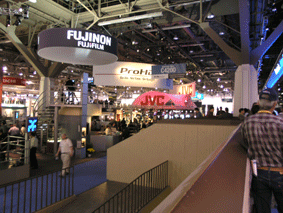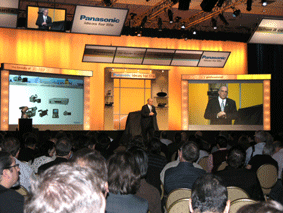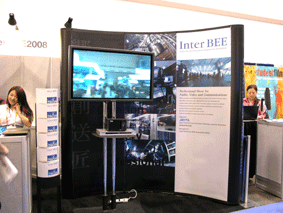Technological Trends at the NAB SHOW 2008 (Part1):Overall Impressions and the Tapeless Broadcast Future
2008.5.8 UP

As a mentor of Inter BEE Japan, the NAB show is now the worlds largest digital media trade fair, and no longer seems limited as a solely American event. The NAB SHOW 2008 was held under the theme 'Where content comes to life' in Las Vegas, Nevada from April 12th to 17th this year. Although the number of overseas visitors was greater than the average year, the total number of visitors to the show was slightly lower than last year. Whether due to the sub-prime loans crisis or economic climate in the US is unclear, however the reasons for the non-participation of usually large exhibitors Apple and AVID are not known. Despite this, the show was attended by about 105,300 visitors, 1600 companies participated, and was rich in subject matter especially against the backdrop of the upcoming Beijing Olympics (dubbed the 'HD Olympics'), the planned switch to all-digital broadcasting next year in the US, and the same planned transition 3 years from now in Japan.
NAB President David K. Rehr emphasized close cooperation with the CATV industry, and serious consideration of content since the closure of analog broadcasting (Scheduled for February 17th 2009) is just around the corner. He urged the broadcast and video industries to seize the opportunities available with digitalization. He also made a strong appeal for the invigoration of conventional radio media.
In spite of the majority of exhibiting companies being from the US, the Japanese section, notable for its scale, was positioned favorably at the exhibition site; a site somewhat larger than Makuhari Messe. The large Panasonic booth held a prominent position in the middle of the central hall. Surrounding were a union of Japanese companies - Fujinon, Victor of Japan, Ikegami Tsushinki, Hitachi International, Photron, Toshiba, Leader Electronics, and Astrodesign. Visitors enjoyed a formidable display of leading edge technology across an abundance of exhibits. Sony held the advantageous position near the south hall entrance, with a diversified exhibits including displays, theater, HD news works, camera corner, HD live work corner, digital cinema corner, and seen in the context of the whole hall, the powerful presence and industry leadership of the international Sony could be easily felt. Also there were Canon, FOR-A, NTT Electronics, KDDI R&D Laboratories, K-Will, Keisoku Giken, Shotoku and others each presenting a competitive edge with their own booths in the Japanese section.
The NHK group exhibited U-HDTV (Super Hi-Vision), various HDTV apparatus, home 3D television on the westernmost end of the central hall, and in spite of the disadvantageous positioning in the exhibition center, the exhibit's unique state-of-the-art and next-generation broadcast technology attracted great attention.
Noticeable among the western companies involved were Quantel, Thomson GrassValley, Microsoft, IBM, Harris, Barco, all of who were popular for the scale and intelligence of their presentations. Another remarkable exhibit was the live broadcast vehicle and coverage helicopter actually brought in to the building. There was some disappointment about the absence of Avid, whose presentations in other years with their large booth and diverse production performances has always been a favorite, however they did hold an exposition in a hotel outside the center, complementing the NAB exhibition.
As well as the equipment exhibits, various symposiums, session and press conferences were held in the exhibition hall and in surrounding facilities. Among the wealth of large scale and flashy presentations, noticeably Sony and Panasonic attracted the attention of a high number of media industry personnel. Those in charge at Sony and Panasonic as well as the local corporations skillfully used big screen displays to advertise their management strategies and promote their exhibits, visitor participation was encouraged, and the various companies proudly expanded and fortified their various alliances. Sony worked to promote the introduction of HD equipment while Panasonic focused on world-wide promotion of P2 HD.
The most noticeable trends at this years NAB show were the furthering of HDTV establishment, widespread tapeless apparatus, high definition thin monitors, H.264 encoding technology, IPTV technology, advanced 4K digital cinema technology, U-HDTV, 3D, and other diverse next-generation screening systems.
Moving towards tapeless operations has always been the goal of the NAB, and this years expo focused on the move away from the conventional with non-linear editing and production systems leading the charge, while companies exhibited a wide variety of equipment from location cameras and recorders, to archiving and transmission systems with the view to expanding into the tapeless broadcasting future.
Sony exhibited their SONAPS system- a total workflow system featuring the top of the range HD422 Series Camcorder with 50Mbps recording, full HD achieved through MPEG-2 long GOP compression using the professional disc (BD) in the XDCAM, and network production link and transmission technology. Also on display and receiving great attention was the compact and lightweight XDCAM EX camcorder fitted with the SXS memory card (a semiconductor memory first displayed last year).
Panasonic had a wonderful line up of their emerging and already successful P2 HD Series (semiconductor memory). Through the use of the high resolution and high efficiency AVC-H.264 Intra for compression encoding, coupled with the 64GB P2 card, enabling about 2 hours recording time at 50 Mbps, a higher level of practically has been achieved.
P2 HD technology was promoted in other affiliated booths such as Quantel, Autodesk and Omneon.
The HD GF (flash memory) series introduced last year by Ikegami Tsushinki and Toshiba was also on display in those company booths. The seamless linkage and workflow displayed between the compact GF Camcorder, GF Recorder and editing equipment received a lot of praise from the visiting public.
Thompson GrassValley continued from last year with removable disc/semiconductor memory hybrid recording media, Infinity DMC Camcorder with selectable MPEG-2, DV25Mbps or JPEG2000. Thomson GrassValley also used a great deal of space to present their combined tapeless production systems.
Inter BEE Management Secretariat also opened its own booth on a block in the central hall, and worked to promote its achievements and "Inter BEE 2008". It should be mentioned that in the Inter BEE Online Magazine page (by Hideichi Tamegaya, added April 21st) it was noted that President Fumio Nobui was awarded special commendation from NAB for leadership in the broadcasting industry. As we know he has a long history of contribution to the broadcasting and video industry in Japan. By receiving this award and through the active participation of the Japanese electronics industry at the NAB, we are delighted to see a strengthening of the alliances between NAB, Inter BEE and the Japanese broadcasting industry as a whole.
Photo 1: The popular and noticeable Japanese corporate booths
Photo 2: The colorful Panasonic press conference
Photo 3: The Inter BEE Management Secretariat booth
Video technology Journalist: Takehisa Ishida









